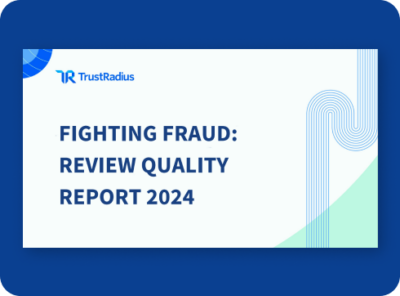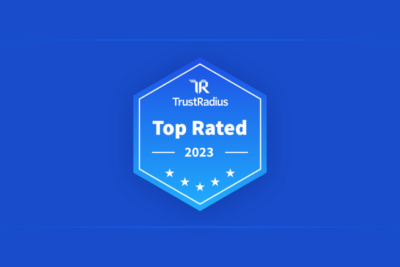Market leaders get 1-star reviews. Here’s what to do when you get one.
Companies like Zoom, Slack, Hubspot, Procore, and Mailchimp are crushing it. Zoom is a household verb with strong revenue growth fueled by the pandemic and shift to remote work. Hubspot’s stock is up, and they’re one of the most-loved apps of all time. Procore’s leading a technology revolution in the construction industry with the financials to prove it. Slack is everywhere, prompting titan Salesforce to scoop them up in an acquisition, much like they did Tableau. Mailchimp defied investor predictions to sell for $12B. Meanwhile, Microsoft and Cisco were two of the top 5 best-performing stocks in 2021.
What do all of these market leaders have in common?
They have hundreds of reviews from happy customers on review sites. Reviewer sentiment is overwhelmingly positive. On TrustRadius, a site notorious for cracking down on bias, anywhere from 45% to 70% are promoters who rate the product a 9 or 10.
They also have 1-star reviews.
77% of products have a 1-star review by the time they reach 100 ratings and reviews on TrustRadius.
By the time they reach 500 ratings and reviews, 99% of products have a 1-star review, and nearly half have a smattering of ten or more 1-star reviews.
For the most part, customers love these products. Their success in the market proves they deliver real value. Hundreds, even thousands, of reviewers recommend them. But no product is perfect. Everyone has their critics, even market leaders. (Any brand without online critics reeks of Orwellian PR tactics. If it seems too good to be true, it probably is.)
What does a 1-star review mean?
A 1-star review means your customer rated their likelihood to recommend your product a 1 or 2 out of 10. This isn’t a run-of-the-mill, things-could-be-better situation. They’ve had a passionately bad experience. 1-star reviews are emotional. Their goal is to draw attention.
1-star reviewers are motivated by the desire to warn their peers. They may be embarrassed about wasting time and money on a product that didn’t work for them. They seek retribution–a refund, or even a simple apology.
Some people look for negative reviews specifically. On TrustRadius, buyers can filter reviews by topic, demographics, or sentiment. 18% of the time, filter users narrow it down based on the overall rating. A third of them want to read 1-star reviews.
But buyers don’t take 1-star reviews at face value. They’re savvy business people. They evaluate the tone of the source and read between the lines. They understand these reviews are on the fringe. It’s the very worst nightmare scenario, written by someone who is in a bad mood.
You may get questions about information gleaned from 1-star reviews, but they won’t stop a sale. (Case in point: 1-star reviews aren’t stopping Zoom, Slack, MailChimp, Procore, Microsoft, or Cisco.)
1-star reviews signal that you’re not controlling the feedback across reviews. Paradoxically, 1-star reviews lead to more trust in your brand, not less. You don’t need to go out of your way to get them. Just be ready for a few to come naturally as you grow your presence on review sites.
How do I respond to a negative review?
You still want to be like Zoom, right? Of course, you do.
On your way to becoming a market leader, you’re going to rack up some 1-star reviews. Follow these three steps to handle it like a pro.
Step 1: Keep calm.
Remember that buyers expect to see 1-star reviews. This is normal. It’s a sign you’re probably on the path to becoming a market leader with a strong customer review presence.
✘ Don’t try to get the review taken down. Reputable review sites will only take down a 1-star review if it’s fake or fraudulent.
✘ Don’t try to figure out who wrote the review if it’s anonymous. Asking the individual to take down their review goes against FTC regulations.
✔ Do let others at your organization know you’re on it. Give executives, PR, and social media folks who are tuned into the voice of the customer a heads up. You don’t want them to be caught by surprise. Reacting defensively could cause an even bigger internet backlash. They need to know you have a plan.
Step 2: Comment ASAP.
Your goal is to extend the olive branch. This comment needs to address the reviewer, but it also needs to signal to buyers reading the review that you are listening to customer complaints.
✔ Do log into the review site with an account that includes your name, title, LinkedIn profile, and a photo. You want anyone reading this to know you are a legit representative of the company.
✘ Don’t argue with the claims in the review, or place blame on the reviewer. When in doubt, take the high road!
✔ Do offer links to documentation, help resources, additional context about features or policies they may be unaware of, and anything else you can do to make it right. Make sure to include contact information. Even if the 1-star reviewer is anonymous, they should be able to reach you. They may even come back and change their review if you can solve their issue.
Step 3: Focus on other reviews.
Once you’ve commented on the 1-star review, point your energy elsewhere.
Is the 1-star review showing at the top of your page? If it is, you need to get some new reviews. Just one new review is a good distraction. Five is even better.
If the 1-star review isn’t showing at the top of your page, you have plenty of other more recent and/or more helpful reviews. You don’t need new reviews. Instead, leverage reviews you already have.
Amplify the reviews from your advocates. Post about great use cases and insightful feedback on social media. Comment on them too. Show buyers you’re engaged with all of your customers, whether they love your product or not.
Sound like a lot of work? Get help from the professionals! TrustRadius offers free tools and paid services to help manage your reputation at every step of the way.





